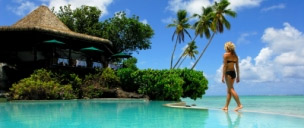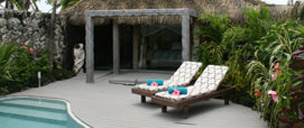THE 15 ISLANDS
SOUTHERN COOK ISLANDS
Rarotonga
Rarotonga is the capital island of the Cook Islands and has the largest population, largest island, and the jewel in the crown – it has the bewitching blend of craggy mountains, dense jungle and glorious bone-white beaches. The encircling lagoon is a major tourist draw for Rarotonga and there are resorts and hotels all the way around the island. The most popular areas are the south-eastern corner at Muri where the lagoon is deep enough for good snorkelling as well as the south and west coasts. Rarotonga is the entry point for the Cook Islands by air. From Rarotonga international airport Air Rarotonga flies to most of the other 15 islands in the group.
Aitutaki
Aitutaki is a 45 minute flight from Rarotonga and is the second most visited island of the Cook Islands. It is also traditionally known as Araura, Ararau and Utataki. This Island is a prime destination, especially for those seeking unbridled romantic ambiance. This small island encased in a triangular barrier reef boasts incredible lagoons. The island enjoys some of the best diving and snorkelling sites in the world with an abundance of tropical corals and colourful marine life.
Atiu
Atiu is the third largest and third most visited island of the Cook Islands. It is also known as Enuamanu which means land of the birds. More species of birds live there than on any of the other islands. But there’s much more to Atiu than just birds, as you’ll find out. It is also known as the most eco-friendly and environmentally minded of the Cook Islands. It supports an amazing variety of natural habitats, from deep underground caves and dense coastal forest to soggy swamps and inland lakes, and the island’s rich wildlife is a major draw. Atiu is about half the size of Rarotonga and about 187 km northeast of it.
Mitiaru
Mitiaro is the fourth island in the Cook Islands group, also known as Nukuroa. This island boasts the only sizeable freshwater lakes in the Cook Islands. Beaches are limited, but there are crystal clear pools in the subterranean limestone caves which are all over the island.
Mangaia
Mangaia is traditionally known as A’ua’uEnua, which means terraced. This island is the oldest island in the Pacific about 18 million years old and also the second largest island in Cook Islands, after Rarotonga. Like many of the southern islands in the Cooks, it’s surrounded by cliffs of fossilised coral, called the Makatea. Mangaia is a peaceful holiday destination perfect for those looking for a peaceful quiet getaway or for those who like to explore nature in its most fascinating and rugged form.
Takutea
The island is sometimes still called Enua-Iti which means Small Island. It is a small uninhabited island 21 km northwest of Atiu. This small island consists of two islets, Manuae and Te Au O Tu, surrounded by a pristine, unbroken reef. The island has been designated a wildlife sanctuary, mainly for the red-tailed tropic birds and red-footed Boobies.
Manuae
Manuae also called Hervey Islands, after a Lord of the Admiralty. It has a total land area of just 6.2 sq km. It was the first island in the country to be discovered by Captain Cook, on September 23, 1773. It comprises two horseshoe-shaped islets, Manuae and Te Au O Tu, both of which lie on the peak of an underwater volcano. This is a protected marine reserve and is an important breeding ground for seabirds and marine turtles in the Central Pacific. The offshore waters of Manuae are good fishing grounds.
Mauke
Mauke is nestled in the south eastern corner of the sunny Cook Islands. It is the most easterly of the islands; about half the size of the main island Rarotonga, in circumference. The geological formation of the island is similar to that of Atiu with some fine caves located in the cliffs of the coral reef. If you are adventurous, you will find a swim in some of the underground caves both refreshing and spectacular. Mauke is also a garden island, extremely verdant and fertile with magnificent hardwood trees in its interior. Mauke has also several beautiful beaches. The best beaches are on the south side of the island and are deserted with long stretches of clean white sand encompassing a turquoise crystal clear lagoon.
Palmerston
Palmerston is located strategically along the path of the trade winds between Borabora in French Polynesia to the east, and Niue to the west. It is a coral atoll in the Cook Islands in one of the most isolated part of the Pacific Ocean. This atoll was discovered on June 16, 1774, by Captain James Cook, on his second voyage to the South Pacific. He named the atoll in honour of Lord Palmerston, one of the Lords of the Admiralty. Palmerston boasting one of the healthiest reefs in the Pacific, snorkelling and swimming amongst the turtles, colourful green parrot fish and amazing marine life is an unforgettable experience.
NORTHERN COOK ISLANDS
Pukapuka
Pukapuka is a true atoll comprising three islets and a sandbank. It is situated relatively close to another Polynesian neighbour, Samoa. Pukapuka has a population of just three hundred people. It has its own language and customs and other Cook Islanders say its main asset is beautiful girls. It is also one of the most remote places on earth, untouched and boasting superb beaches and an amazing array of marine life.
Penrhyn
Penrhyn is also known as Tongareva, lies 1,365 kilometres north of Rarotonga. Penrhyn is the most remote and largest atoll of the 15 Cook Islands in the South Pacific Ocean. It comprises a series of narrow motus (islands) enclosing one of the largest lagoons in the Pacific. Penrhyn is peaceful haven of tranquility. People live a largely subsistence life supplemented by diving for natural pearls and Mother of Pearl shell. If you wish to visit here, activities are: fishing trips with the local islanders, boating trips to the village of TeTautu located on the opposite side of the lagoon, or the reef trips to explore the many motus and gather oysters.
Manihiki
Experience an island very few people have ever visited. Manihiki is one of the Pacific’s most beautiful atolls. It is a triangular atoll and also known as the Island of Pearls. It sits on top of an underwater mountain which rises 13,000 feet (4,000 m) from the ocean floor. The atoll is a continuous rim of reef without lagoon entrances. Manihiki’s lagoon is straight out of a story book with many motu’s also known as islets, strung along the reefs which are always warm and the marine life is brightly coloured. There is excellent swimming, snorkelling and diving.
Rakahanga
Rakahanga is situated in the central-southern Pacific Ocean and is the sister island of Manihiki. Rakahanga is a rectangular atoll with a land area the same as Pukapuka. This island is a small atoll, a continuous ring of coral reef surrounding a shallow lagoon. It has the distinction of being the first of the Cook Islands to have a recorded landing by Europeans. The pearl industry is still in its infancy here and this is a much quieter island than Manihiki. Rakahanga also is one of the most isolated islands in Cook Islands.
Suwarrow
Suwarrow is perhaps the most famous of the Cook Islands after Rarotonga and Aitutaki. A true atoll, this island was declared a national park in the 1978 and is the only one of its kind in the Cook Islands. Suwarrow National Park is home to a unique array of bird and marine life. This island also described as “the most romantic island in the world”- it’s isolated and uninhabited for most of the year.The atoll here has one of the best harbors in the Pacific. It is quadrilateral in shape and 50 miles (80 km) in circumference. The atoll also is a popular spot for yachts to visit on their way to western cyclone havens in Tonga, Fiji, New Zealand and Australia. Visitors here are provided with guided opportunities to hunt and catch coconut crabs, lobsters, spearfish, snorkel, dive, and lazily cast in a line from the back of their boats. What make this tiny island so special are not only its many natural wonders, but its historical significance as well.
Nassau
Nassau is one of the smallest of the Cook Islands. It is just 9 metres above sea level, with an oval sandy cay on a coral reef foundation and is surrounded by a narrow reef flat. It is the only northern island without an inner lagoon. There is only one village on Nassau and most of the people here are farmers, growing coconuts and taro. This tiny island was once part of the Pukapuka Atoll, with a population of just 100 people. Nassau is the most isolated of the Cook Islands. If you want to visit Nassau, you will need permission to get here. The only way to get here is by boat from the Pukapuka Atoll, which is a 3 day journey.





